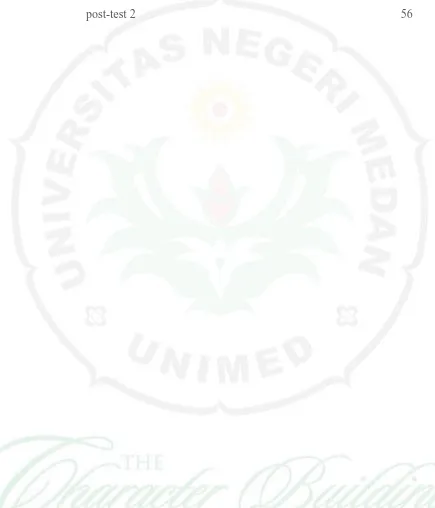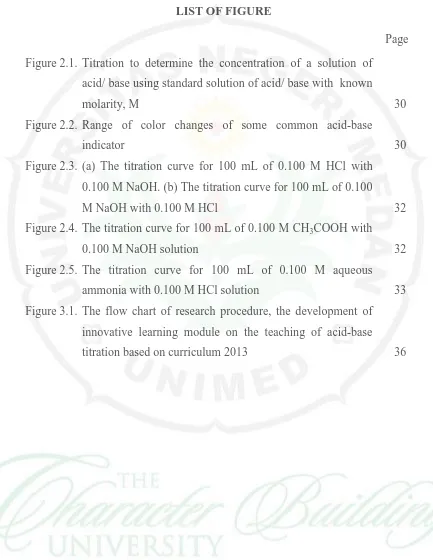iii
THE DEVELOPMENT OF INNOVATIVE LEARNING MODULE ON THE TEACHING OF ACID-BASE TITRATION
BASED ON CURRICULUM 2013
Debby Suci Martalina (Reg. Number : 4103332002) ABSTRACT
vi
TABLE OF CONTENT
Page
Ratification Sheet i
Biography ii
Abstract iii
Acknowledgement iv
Table of Content vi
List of Figure ix
List of Table x
List of Appendix xii
CHAPTER I INTRODUCTION
1.1 Research Background 1
1.2 Problem Identification 5
1.3 Research Scope 5
1.4 Problem Formulation 5
1.5 Research Objectivef 6
1.6 Research Benefit 6
CHAPTER II LITERATURE STUDY
2.1 Innovative Learning Module 8
2.1.1 Procedure of Writing Module 11
2.1.2 Module and Textbook in Education 14
2.2 Curriculum 2013 for SHS 17
2.3 Chemistry Subject in Curriculum 2013 18
2.4 Chemistry Module as Teaching Media 25
2.5 Innovation of Learning Media in Chemistry 26
2.6 Laboratory Experiment in Chemistry 27
2.7 Innovation of Learning Media in Chemistry 28
2.8 Chemistry Subject on Acid – Base Titration Based on Curriculum 2013 29
vii
2.8.2 Indicator for Acid-Base Titration 30
2.8.3 Calculation in Acid-Base Titration 30
2.8.4 Types of Acid-Base Titration and Its Curve 31
2.9 Research Hypothesis 33
CHAPTER III RESEARCH METHODOLOGY
3.1Research Overview 34
3.2Research Location and Time 34
3.3Research Population and Time 34
3.4Research Variable and Instrument 35
3.5Research Design 34
3.6Research Procedure 38
3.7Data Analysis Technique 41
3.7.1 Descriptive Analysis 42
3.7.2 Inferential Analysis 43
3.7.2.1The Homogeneity Test 43
3.7.2.2The Hypothesis Test 43
3.7.2.3The Percentage of Effectivity 44
CHAPTER IV RESULT AND DISCUSSION
4.1Survey of High School Bilingual Chemistry Textbook 45
4.2Descriptive Analysis of High School Bilingual Chemistry Textbook 46
4.3Development of Innovative Chemistry Learning Module 49
4.4Developed Research Instrument 51
4.5Standarization of Innovative Chemistry Learning Module 51
4.6Inferensial Analysis 52
4.6.1 The Normality Test 52
4.6.2 The Homogeneity Test 53
4.7.Effectivity of Innovative Learning Module on The Teaching of Acid –
Base Titration 52
viii
4.9.The Percentage of Effectivity 59
4.10. Discussion 59
CHAPTER V CONCLUSION AND SUGGESTION
5.1Conclusion 63
5.2Suggestion 64
x
LIST OF TABLE
Page
Table 2.1. The diffrences between module and textbook 14
Table 2.2. The Differences between curriculum 2013 and KTSP 17
Table 2.3. Core competence and basic competence for chemistry
subject Class XI for SMA/MA in curricum 2013 21
Table 3.1. The research design of the development of innovative
learning module on the teaching of acid-base titration based
on curriculum 2013 37
Table 3.2. Analysis of Suitable the Chemistry Learning Module or
textbook for Senior High School with Curriculum 2013 on
The Teaching of Acid of Acid-Base Titration 39
Table 3.3. Questionnaire of chemistry learning module for Senior High
School with curriculum 2013 on the teaching of Acid-Base
Titration 41
Table 4.1. The description of bilingual chemistry textbook that are
included in the survey 45
Table 4.2. The suggested sub-chapter for innovative learning module
of acid – base titration 46
Table 4.3. Table percentage average of suitable of description material
for analyzed textbooks 48
Table 4.4. Type of innovation in chemistry learning module on the
topic of acid – base titration 50
Table 4.5. The questionaire result of innovative chemistry learning
module standarization by chemistry lecturers, teachers, and
students. 52
Table 4.6. Average and standard deviation of student’s achievement
in pretest 54
Table 4.7. Average and standard deviation of student’s achievement in
xi
Table 4.8. Average and standard deviation of student’s achievement in
ix
LIST OF FIGURE
Page
Figure 2.1. Titration to determine the concentration of a solution of
acid/ base using standard solution of acid/ base with known
molarity, M 30
Figure 2.2. Range of color changes of some common acid-base
indicator 30
Figure 2.3. (a) The titration curve for 100 mL of 0.100 M HCl with
0.100 M NaOH. (b) The titration curve for 100 mL of 0.100
M NaOH with 0.100 M HCl 32
Figure 2.4. The titration curve for 100 mL of 0.100 M CH3COOH with
0.100 M NaOH solution 32
Figure 2.5. The titration curve for 100 mL of 0.100 M aqueous
ammonia with 0.100 M HCl solution 33
Figure 3.1. The flow chart of research procedure, the development of
innovative learning module on the teaching of acid-base
xii
LIST OF APPENDIX
Page
Appendix 1. Innovative learning module of acid – base titration based
on curriculum 2013 68
Appendix 2. Syllabus of chemistry subject 69
Appendix 3. Lesson plan of experiment and control class 72
Appendix 4. Spesification table of student’s achievement test 87
Appendix 5. Instrument Test 100
Appendix 6. Key Answers 106
Appendix 7. The questionnaire for trial the innovative learning
module of chemistry on the topic of acid –base titration 107
Appendix 8. Descriptive analysis of high school bilingual chemistry
textbook 108
Appendix 9. Calculation of validation test 112
Appendix 10. Table of validity test 113
Appendix 11. Calculation of reability test 115
Appendix 12. Table reability test 116
Appendix 13. Calculation of difficulty level test 118
Appendix 14. Table of difficulty level test 119
Appendix 15. Calculation of discrimination index test 121
Appendix 16. Table of discrimination index test 122
Appendix 17. The questionnaire for trial the innovative learning
module standarization by chemistry lectureres of States
University of Medan 125
Appendix 18. The questionnaire for trial the innovative learning
module standarization by teachers of MAN 2 Model
Medan, Man 1 Medan, and SMAN 5 Binjai 126
Appendix 19. The questionnaire for trial the innovative learning
module standarization by students of MAN 2 Model
xiii
Appendix 20. The questionnaire for trial the innovative learning
module standarization by lecturer, teachers, and students
of MAN 2 Model Medan, MAN 1 Medan, and SMAN 5
Binjai 128
Appendix 21. Table of grouping class (high and low group) for three
senior high school 129
Appendix 22. Calculation of normality test 135
Appendix 23. Calculation homogeinity test 141
Appendix 24. Calculation of hypothesis test 143
Appendix 25. The percentage average of student’s achievement 149
Appendix 26. The Percentage of Effectivity 150
Appendix 27. Research Documentation 151
65
REFERENCES
Ali, R., Ghazi, S.R., Khan, M.S., Hussain, S., and Faitma, Z.T., (2010), Effectiveness of Modular Teaching in Biology at Secondary Level, Asian Social Science 6(9) 49-50
Aman, (2009), Kajian Model-Model Ecaluasi Program Pendidikan, FIS UNY, Yogyakarta:http://staff.uny.ac.id/system/files/penelitian/Dr.%20Aman,% 20M.Pd./B 14.PENELITIAN.pdf s
Atinhaibara, (2013), Dinamika Peningkatan Kualitas Pendidikan dengan Kurikulum 2013: http://atinhaibara.wordpress.com/pendidikan/dinamika-peningkatan-kualitas-pendidikan-dengan-kurikulum-2013/ (Accessed on January 2014)
Brady,J.E.,Russel,J.W., and Holum,J.R., (2000), Chemistry: Matter and Its Changes,John Wiley & Sons,Inc, New York
Dharma, S.,(2008),Penulisan Modul,Direktorat Jendral Peningkatan Mutu Pendidikan dan Tenaga Kerja Kependudukan Departemen Pendidikan Nasional, Jakarta
Frananta, D.S., (2013), The effectivity of Innovated Learning Module and Demonstration Method with Macromedia Flash Animation to Improve Student’s Achievement on The Teaching of Salt Hydrolysis., Skripsi, FMIPA, Unimed, Medan
Gusriwan, (2012), Titrasi Asam-Basa:
http://gusriwan39.files.wordpress.com/2012/02/titrasi.ppt. (Accessed on January 2014)
Hardila,V., (2012), The Influence of Critical Thinking Developments in Learning Slat Hydrolysis Concept Through Chemistry Modules to Increase Student’s Achievement Grade XI., Skripsi, FMIPA, Unimed, Medan
Hofstein,A., (2004), The Laboratory in Chemistry Education: Thirty Years of Experience with Developments, Implementation, and Research, Chemistry Education: Research and Practice 5(3): 284
66
Kentari, K., (2012), Model Pembelajaran Learning Cycle 7E dengan Metode Praktikum pada Titrasi Asam-Basa untuk Meningkatkan Penguasaan Konsep dan Keterampilan Berpikir Kritis Siswa SMA, Tesis, UPI, Bandung
Kurbangku, N.I., and Akin, A., (2010), The Relationships between University
Student’s Chemistry Laboratory Anxiety, Attitudes, and Self-Efficacy Beliefs, Australian Journal of Teacher Education 35(2): 48
Maciejowska, I., (2007), Chemical Education Outside a Classroom Step by Step, Department of Chemical Education, Faculy of Chemistry Jagellonian, Poland:http://www.citieseu.org/sites/default/files/attachments/066_outdo or_activities-cities-iwona.pdf.
Media Pendidikan Indonesia, (2013), Karakteristik Kurikulum 2013: http://www.m-edukasi.web.id/2013/06/karakteristik-kurikulum2013.html (Accessed on April, 2014)
Muslimah, Y., (2012), Meningkatkan Aktivitas dan Hasil Belajar Siswa Pada Materi Hidrolisis Garam Melalui Model Student Teams Achievement Division (STAD), Jurnal Vidya Karya 27(1): 25-26
Notodiputro, K.A.,(2013), Kompetensi Dasar SMA/MA, Kementerian Pendidika dan Kebudayaan 2013, Jakarta
Rachmawati,R., and Johari.,(2010),Chemistry 2 for Senior High School Grade XI, PT. Gelora Aksara Pratama, Jakarta
Parulian, H.G., and Situmorang, M., (2013), Inovasi Pembelajaran di Dalam Buku Ajar Kimia SMA untuk Meningkatkan Hasil Belajar Siswa Kelas XI, Jurnal Penelitian Bidang Pendidikan 19(2): 74-76
Silitonga, P.M., (2011), Statistik Teori dan Aplikasi Dalam Penelitian, FMIPA Unimed, Medan
Simatupang, N.I., and Situmorang, M., (2013), Innovation of Senior High School Chemistry Textbook to Improve Students Achievement in Chemistry, The 2nd International Conference of The Indonesian Chemical Society in Chemistry 2013 October, 22 – 23th 2013,Page 44 - 42
67
Situmorang,M.,(2010), Penelitian Tindakan Kelas (PTK) Untuk Mata Pelajaran Kimia, Universitas Negeri Medan, Medan
Situmorang, M., (2013), Pengembangan Buku Ajar Kimia SMA Melalui Inovasi Pembelajaran dan Integrasi Pendidikan Karakter untuk Meningkatkan Hasil Belajar Siswa, Prosiding Seminar dan Rapat Tahunan BKS PTN-B
Bidang MIPA di Bandar Lampung, May, 10-12nd 2013, Page 237-246
Situmorang, M., Simaremare, B., Elnovrey, J., Naiborhu, P.D., and Sumbayak, D., (2012), The Development of Chemistry Learning Module for RSBI Senior High School Students, Research Report of Teaching Grant KBI FMIPA UNIMED, Medan
Situmorang, M., Sinaga, M., Tarigan, D.A.B., Sitorus, C.J., and Tobing, A.M.L., (2011), The Effectivity of Innovated Chemistry Learning Methods to
Increase Student’s Achievement in Teaching of Solubility and Solubility Product, Jurnal Penelitian Bidang Pendidikan 17(1): 29-31
Situmorang, M., Sinaga, M., Tobing, A.M.L., Sitorus, C.J., and Tarigan, D.A.B., (2009), Innovation of Laboratory Experiment and Demonstration Method to Increase Students Achievement in teaching od solubility and solubility product, Research Proposal Teaching Grant KBI FMIPA Unimed, Medan
Situmorang, M., Suyanti, R.D., Simatupang, N.I, and Munthe, S.D.D., (2013), Pengembangan Buku Ajar Kimia SMA/MA Kelas X Sesuai Kurikulum 2013 Melalui Inovasi Pembelajaran untuk Meningkatkan Hasil Belajar Siswa, Prosiding Seminar Penelitian Unimed, Lembaga Penelitian Unimed, Medan
Thok, F., (2013), Perbedaan Kurikulum 2013 dan KTSP: http://fatkoer.wordpress.com/2013/07/28/perbedaan-kurikulum-2013dan-ktsp/ (Aceessed on April, 2014)
Wahid, M.R., (2013), Kriteria Pendidikan Scientific: http://mrwahid.wordpress.com/2013/09/05/1015/(Accessed on April, 2014)
Whitten, K.W., Davis, R.E., and Peck, M.L., (1996), General Chemistry,Saunders collage Pub, Georgia

